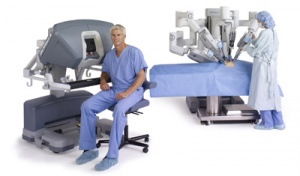Difference between revisions of "Da Vinci Surgical System"
(Created page with "File:Da-vinci-system-si-seated-surgeon-nurse-at-cart-400x235.jpg|300px|thumbnail|right| [http://www.davincisurgery.com/da-vinci-surgery/da-vinci-surgical-system/ Da Vinci Su...") |
|||
| Line 3: | Line 3: | ||
{{Nav-Bar|Topics#A}}<br> | {{Nav-Bar|Topics#A}}<br> | ||
| − | '''Da Vinci Surgical System''' is a minimally invasive surgery | + | '''Da Vinci Surgical System''' is a minimally invasive surgery performed with robotic assistance. The Da Vinci was created by Intuitive Surgical and is currently the only approved robotic surgical system approved by the Food and Drug Administration. The Da Vinci has been famed for its increased precision and enhanced range of motion in comparison to open surgery. Within the last 14 years, 1.75 million of these robotic procedures have been performed in the United States. <ref>Alemzadeh, Homa et al. “Adverse Events in Robotic Surgery: A Retrospective Study of 14 Years of FDA Data.” Ed. Hyun-Sung Lee. PLoS ONE 11.4 (2016): e0151470. PMC. Web. 20 Feb. 2017.</ref>: |
| + | |||
| + | ==System Overview== | ||
| + | The system consists of two separate consoles the surgeon's console and the robotic console. The surgeon's console is where the surgeon sits and is provided with high quality 3D visual feedback. He or she is able to control the separate robotic console with the use of hand manipulators and foot pedals. This separate robotic console consists of four arms. One arm holds a laparoscopic camera that provides the visual feedback to the surgeon console, and the other three arms are used to hold surgical instruments.<ref>Schreuder, H. and Verheijen, R. (2009), Robotic surgery. BJOG: An International Journal of Obstetrics & Gynaecology, 116: 198–213. doi:10.1111/j.1471-0528.2008.02038.x</ref>: | ||
==Medical Uses== | ==Medical Uses== | ||
| Line 18: | Line 21: | ||
The average machine unit cost is $1 to $2.5 million. On a procedural basis, the da Vinci surgery is an additional $1,600 than the general procedure without robotic assistance, this is about a 6% increase. <ref>Barbash, Gabriel I., M.D., and Sherry A. Glied, PhD. "New Technology and Health Care Costs - The Case of Robot-Assisted Surgery — NEJM." New England Journal of Medicine. The New England Journal of Medicine, n.d. Web. </ref>: Most insurance companies do not reimburse more money for these robotic assisted procedures then they would for the general procedure. | The average machine unit cost is $1 to $2.5 million. On a procedural basis, the da Vinci surgery is an additional $1,600 than the general procedure without robotic assistance, this is about a 6% increase. <ref>Barbash, Gabriel I., M.D., and Sherry A. Glied, PhD. "New Technology and Health Care Costs - The Case of Robot-Assisted Surgery — NEJM." New England Journal of Medicine. The New England Journal of Medicine, n.d. Web. </ref>: Most insurance companies do not reimburse more money for these robotic assisted procedures then they would for the general procedure. | ||
| − | ==Patient Risk | + | ==Patient Risk== |
==References== | ==References== | ||
Revision as of 16:31, 20 February 2017
Da Vinci Surgical System is a minimally invasive surgery performed with robotic assistance. The Da Vinci was created by Intuitive Surgical and is currently the only approved robotic surgical system approved by the Food and Drug Administration. The Da Vinci has been famed for its increased precision and enhanced range of motion in comparison to open surgery. Within the last 14 years, 1.75 million of these robotic procedures have been performed in the United States. [1]:
System Overview
The system consists of two separate consoles the surgeon's console and the robotic console. The surgeon's console is where the surgeon sits and is provided with high quality 3D visual feedback. He or she is able to control the separate robotic console with the use of hand manipulators and foot pedals. This separate robotic console consists of four arms. One arm holds a laparoscopic camera that provides the visual feedback to the surgeon console, and the other three arms are used to hold surgical instruments.[2]:
Medical Uses
Types of Surgeries Completed with the da Vinci[3]:
- Cardiac Surgery
- Colorectal Surgery
- General Surgery
- Gynecologic Surgery
- Head & Neck Surgery
- Thoracic Surgery
- Urologic Surgery
Costs
The average machine unit cost is $1 to $2.5 million. On a procedural basis, the da Vinci surgery is an additional $1,600 than the general procedure without robotic assistance, this is about a 6% increase. [4]: Most insurance companies do not reimburse more money for these robotic assisted procedures then they would for the general procedure.
Patient Risk
References
- ↑ Alemzadeh, Homa et al. “Adverse Events in Robotic Surgery: A Retrospective Study of 14 Years of FDA Data.” Ed. Hyun-Sung Lee. PLoS ONE 11.4 (2016): e0151470. PMC. Web. 20 Feb. 2017.
- ↑ Schreuder, H. and Verheijen, R. (2009), Robotic surgery. BJOG: An International Journal of Obstetrics & Gynaecology, 116: 198–213. doi:10.1111/j.1471-0528.2008.02038.x
- ↑ "The Da Vinci® Surgical System." Da Vinci Surgery - Minimally Invasive Robotic Surgery with the Da Vinci Surgical System. N.p., n.d. Web.
- ↑ Barbash, Gabriel I., M.D., and Sherry A. Glied, PhD. "New Technology and Health Care Costs - The Case of Robot-Assisted Surgery — NEJM." New England Journal of Medicine. The New England Journal of Medicine, n.d. Web.
